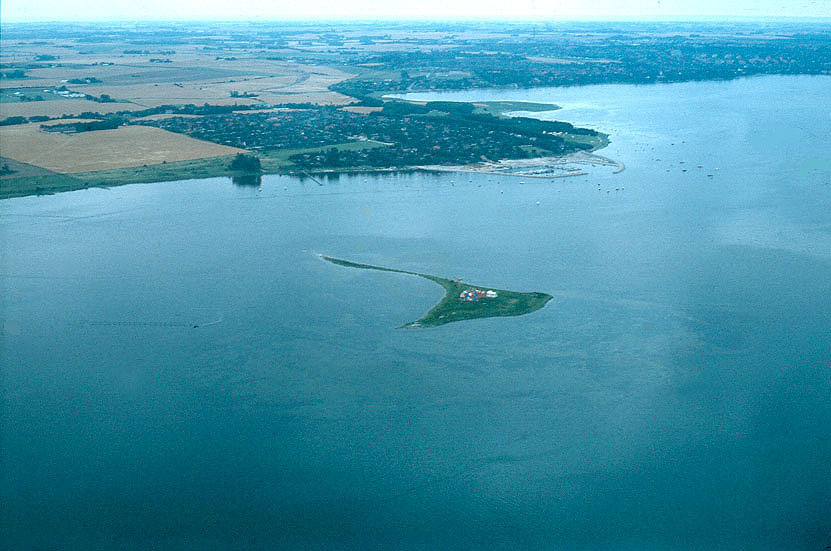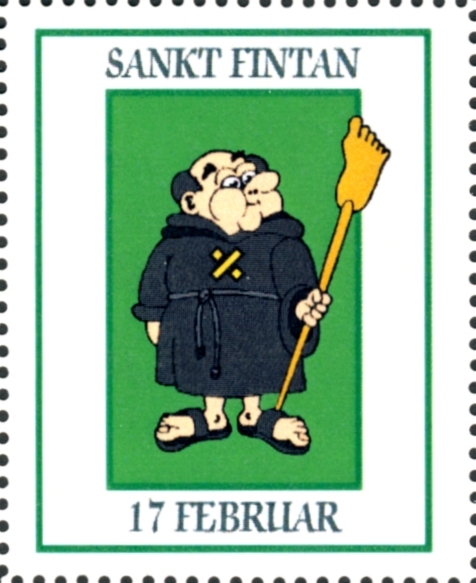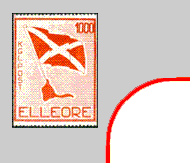Unlike
your normal micronation, Elleore's history has many facets. There is
the isle itself, the people behind the establishment of the Kingdom and
the most intriguing legend around the prehistory. Therefore this
section is divided into a number of subsections.
The History of the Isle

Elleore
is shaped like an 'L', 300 m in east-west and 200 m in north-south
direction. It is located in Roskilde Fjord, 4 km north of the city of
Roskilde. Since the Reformation, the isle belonged to the City of
Copenhagen. In 1847, they sold it to a well-known City Councillor.
In
the year 1907, Elleore was destined to become famous all over
Scandinavia. Ole Olsen, a great movie pioneer, decided to record a
movie there called 'Lion Hunt on Elleore'. He had two adult lions
acquired from Hagenbeck in Hamburg/Germany and transferred to the isle.
There were mock-up palm trees and game hunters in tropical clothing
hunting the lions, who were finally killed.
The real death of the
lions brought the Danish Minister of Justice, Mr. Alberti, into the
picture. He banned the movie from all Danish cinemas, which caused
worldwide press coverage. It premiered in Sweden and was a runaway
success all over Scandinavia.
In conjunction with other shady dealings, Mr. Alberti had to resign his
Cabinet post soon after the Elleore affair.
By
1944, the isle had passed into the possession of a Reverend Lange.
After much deliberation he decided to sell it to the founders of
Elleore, as they could convince him that the isle would offer pleasure
to many people in this way.
The Founders of the Kingdom

In
1834, Danish historian Frederik Barfod (1811-1896) - in cooperation
with a charity - founded a boys school where most of the lessons were
free of charge. This concept was very successful, and the teachers soon
formed a close-knit community. The language teachers of Barfod School
founded the ‘Societas Findani’, named after St. Fintan, who many
centuries ago in Ireland also taught pupils free of charge, on 17 February 1938
(St. Fintan’s Day).
The society pursued the extraordinary aim of
establishing their own state where St. Fintan’s ideas could be realized
- no mean feat in the middle of war-torn Europe. The group who was soon
called ‘The Immortals’ began to search for somewhere outside the school
grounds to establish this state. Two of their number formed the ‘Great
Land and Sea Commision’ and went on a long fact-finding mission in a
sailing boat. They looked at isles as candidates for a purchase.
Finally, they found Elleore, a most suitable isle in Roskilde Fjord.
After serious deliberations and negotiations with the owner, the deal
was struck on 27 August 1944. Elleore was to be the home of the
society’s Findanian state – the Kingdom of Elleore was born.
The Legend

According
to the legend of Elleore, the Krune Convent Chronicles were unearthed
at the ruins of the Convent building. They paint a colourful if
inventive and surprising picture of the prehistory of Elleore and its
connection to St. Fintan himself. So be aware that the following
paragraphs are best read with a pinch of salt.
In the 6th
century, the monk St. Fintan lived an ascetic life of mildness and
kindness in Ireland, where he founded Clonenagh Monastery. As patron
saint of Elleore, the date of his death (17 February 603) is Elleore’s
National Day. In Elleore he is regarded as the ‘great teacher’.
By
the 8th century, the monastry belonged to the strict reform movement of
the Irish Church called ‘culdaeism’. During the following century, the
Church in Rome tried to suppress that movement in their efforts to
unify the Church. At the same time, Viking raids increased on Irish
shores. So in the 10th century, the monks from Clonenagh were forced to
leave their home to seek shelter elsewhere. They first went to the Isle
of Man, where they stayed for a while. They continued further North
until they reached the isle of Amitsoq near Greenland.
After
staying there for a while, living conditions become insufferable, so
that the monks decided to retrace their steps and sail back South.
However, adverse westerly winds drove them to the southeast instead, so
that they reached Danish waters. Eventually, they arrived in Roskilde
Fjord and found the isle of Elleore, where they went ashore on 17
February 944. By a surprising coincidence, this is also St. Fintan’s
Day.
The monks were delighted with their new home and went to
work, building Krune Convent. A long history of able abbots and monks
ensued, with a nuns’ convent alongside. This long era of peace and
prosperity for the isle came to an abrupt end in 1535, when during the
Reformation the citizens of Roskilde stormed Elleore and destroyed the
convent. The monks and sisters had to flee and seek sanctuary in the
surrounding region. The last abbot is quoted as forecasting that
Elleore would rise again someday. He was to be proven right many
centuries later.
The era after the eviction from their home is
termed ‘Misery’. Nevertheless, it proved to be very productive for the
fine arts. Books and plays were written, paintings were created, songs
were sung, all still revered today. The universities of Elleore hold
lectures on these subjects to educate the citizens in their rich
artistic history.
In 1944, the ‘Societas Findani’ purchased the isle of Elleore. Thus the
Kingdom of Elleore was born.
Life in the Kingdom

The
language teachers of Barfod’s School in Copenhagen who had formed the ‘Societas Findani’,
decided to acquire an island base for their activities. This was no
small project, and a commission was sent out to check out the options.
After long negotiations the society finally managed to purchase the
isle of Elleore.
So in August 1944, Elleore emerged as Scandinavia’s fourth largest
kingdom.
In
the beginning, when the country was still young, government was
organized in the form of a secret cabinet. This meant that the people’s
power was somewhat limited.
When Elleore had matured for some
decades, the citizens found it unsuitable to have a secretive
leadership. The famous Revolution occurred in August 1969, when the
then underground Revolutionary Party seized the entire political
leadership of the country to push through political reforms. As an
immediate reaction to the conflict settled by negotiation, the
political system was restructured. After that, administrative organs
were created and a ‘normal’ cabinet of ministers was installed. As
there were no hard feelings all through this difficult phase, the event
was called ‘Cultured Revolution’ in the aftermath.
In the same
year, there was one of the numerous attempts by Danish authorities to
infringe on Elleore’s sovereignty. A ship full of youthful invaders
from Roskilde landed, intent on a takeover. However, after passing
through passport checkpoints, the ensuing ‘battle’ was decidedly
undramatic. Later that year, officials from both sides concluded the
Roskilde Peace agreement.
The busiest time of each year is
Elleuge (Elleweek). This is the only time of the year most citizens
spend in their home country. During the other 51 weeks they are said be
‘on an extended stay abroad’. The capital of Elleore, Maglelille is put
up each year and consists of the great town hall tent and many other
tents of the citizens grouped around it as defined by the town map.
During this week, colourful competitions are held. One is Ellympics,
where unusual sporting events are staged (Calf-throwing, Crackers,
Andalusian Mountain Ludo). Another is the Ellevision Song Contest.
Other
important events throughout the year are the Court Ball in spring and Land Cadet Academy Courses. They are held
outside Elleore, however, because the isle is a bird sanctuary
protected by the European Union and may only be ‘settled’ during
Elleweek.
There are four universities in Elleore, where
unsurprisingly courses are
only held during Elleweek. These are Sankt Fintans Univertetet,
Cathedral Universitetet, Højekjøbing Universitets Center (H.U.C.) as
well as Academiet for Skjønne Kunster (A.S.K.).
Elleore
has begun to issue postage stamps in 1947. Up to the present day,
more than 1000 issues have seen the light of day. The earlier ones are
really hard to find nowadays. Since 1962, there have also been annual
Christmas label issues.
A number of banknotes and coins have also
been issued by Elleore’s National Bank over the decades. Between the
1950’s and 1979, a bewildering array of monetary units was in use. Not
for all of them coins or banknotes actually existed. In 1979, the Leo
d’Or was introduced to replace all the others. There are some coins
denominated in Leo d’Or.
The official publication of the country
is Elleblad, It started in 1944 with rather primitive printing
techniques, but nowadays after more than 70 years, it is a colourful A5-sized
magazine. With this medium, the Government can inform its citizens
about important events, decisions, stamp issues, etc.

